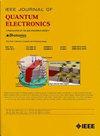与无源波导集成的高速混合调制半导体激光器的数值分析
IF 2.2
3区 工程技术
Q3 ENGINEERING, ELECTRICAL & ELECTRONIC
引用次数: 0
摘要
对集成了无源波导的混合调制激光二极管的高速本征调制特性进行了数值分析。结果表明,3dB 的本征小信号调制带宽取决于分布式反馈(DFB)部分波纹光栅的耦合系数 $\kappa $ 以及 DFB 和腔内损耗调制部分的调制幅度比(MAR)。当 $\kappa $ 减少和 MAR 增加时,调制带宽变宽。当 $\kappa $ 和 MAR 分别为 40 至 80 cm-1 和 6.4 V 时,最大 3-dB E/O 调制带宽超过 600 GHz;当 $\kappa $ 为 40 至 200 cm-1 和 MAR 为 3.2 至 6.4 V 时,最大 3-dB E/O 调制带宽仍超过 300 GHz。利用 200 Gbit/s 的非归零(NRZ)调制信号对激光器的动态单模工作进行了数值演示。在较宽的工作范围和高达 300 Gbit/s 的较高比特率下,确认了清晰的开眼光学 NRZ 图案,开眼区域的最小消光比超过 1.0 dB。本文章由计算机程序翻译,如有差异,请以英文原文为准。
Numerical Analysis for High-Speed Hybrid- Modulation Semiconductor Laser Integrated With Passive Waveguide
The high-speed intrinsic modulation characteristics of a hybrid-modulation laser diode integrated with a passive waveguide was numerically analyzed. It was confirmed that the 3-dB intrinsic small-signal modulation bandwidth depended on the coupling coefficient of the corrugation grating
$\kappa $
at the distributed feedback (DFB) section and modulation amplitude ration (MAR) at the DFB and intra-cavity loss-modulation sections. The modulation bandwidth became wider when
$\kappa $
decreased and MAR increased. The maximum 3-dB E/O modulation bandwidth was more than 600 GHz when
$\kappa $
and MAR were from 40 to 80 cm−1 and 6.4 V. It remained more than 300 GHz when
$\kappa $
was from 40 to 200 cm−1 and MAR was from 3.2 to 6.4 V. Dynamic single-mode operation of the laser was demonstrated numerically with a 200-Gbit/s non-return-to-zero (NRZ) modulation signal. A clear eye-opened optical NRZ pattern with a minimum extinction ratio at the eye-opening area of more than 1.0 dB was confirmed in a wide operation range and at a higher bit rate up to 300 Gbit/s.
求助全文
通过发布文献求助,成功后即可免费获取论文全文。
去求助
来源期刊

IEEE Journal of Quantum Electronics
工程技术-工程:电子与电气
CiteScore
4.70
自引率
4.00%
发文量
99
审稿时长
3.0 months
期刊介绍:
The IEEE Journal of Quantum Electronics is dedicated to the publication of manuscripts reporting novel experimental or theoretical results in the broad field of the science and technology of quantum electronics. The Journal comprises original contributions, both regular papers and letters, describing significant advances in the understanding of quantum electronics phenomena or the demonstration of new devices, systems, or applications. Manuscripts reporting new developments in systems and applications must emphasize quantum electronics principles or devices. The scope of JQE encompasses the generation, propagation, detection, and application of coherent electromagnetic radiation having wavelengths below one millimeter (i.e., in the submillimeter, infrared, visible, ultraviolet, etc., regions). Whether the focus of a manuscript is a quantum-electronic device or phenomenon, the critical factor in the editorial review of a manuscript is the potential impact of the results presented on continuing research in the field or on advancing the technological base of quantum electronics.
 求助内容:
求助内容: 应助结果提醒方式:
应助结果提醒方式:


